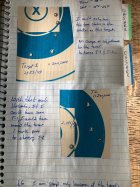foxguy
Gold $$ Contributor
Curious, I would like to see groups 15,16,17 if they were shot. and would like to see position of impact and grouping.Not much time today. Still cleaning up from the storms Friday night.
It really doesn't matter if the target is this sine test or if it's fired in a match, the group SHAPES still happen in the same progression. The sine test just offers more info to work from, but not needed once tuned for a given load...Maybe more on that later but I've discussed it many, many times on here.
For the context of your question, just look at 10, 11, and 12 on here. Forget everything except group SHAPE! This is EXACTLY what I look for the groups to do, moving MY standard tuner ONE mark at a time.
In this very clear(to me) example, if I get vertical(11), I'd move the tuner IN one mark. If I get 12, I move in two marks. The beauty of the sine test is it shows you how far, which way, top and bottom of swing, as well as mark values and how far between sweet spots. You must establish mark values relative to group shapes or else, you're guessing, no matter what tuner or who it is shooting.
Yessir!!! It IS that predictable too!
Later!
View attachment 1661577













